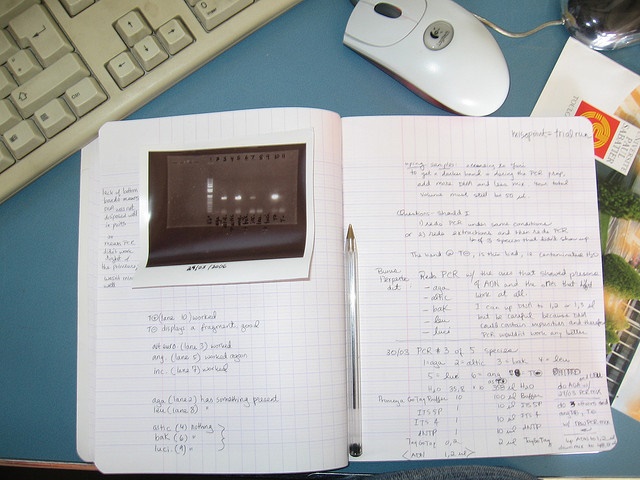Whether you are embarking on a PhD in molecular biology, trying to amplify a new gene, analyzing gene expression by qPCR, or trying to solve a PCR problem, you will probably resort to a Google search at some point or another.
How do you sort out the > 20 million hits you get when you Google ‘PCR’? This list of the Top 10 PCR websites contains those used by myself and colleagues and should be a good go-to for any of the following PCR issues:
- Primer design
- Calculating general properties of primers and amplicons (Tm, secondary structure, primer dimers)
- Predicting off-target amplification
- Restriction mapping of your PCR product to aid cloning
- Relative gene expression analysis for your raw qPCR data
- Estimating PCR efficiency from the slope of an amplification curve so you don’t need to run standard curves in qPCR
- Looking for new PCR reagents and equipment
- PCR troubleshooting and advice
- PCR protocols
1. Primer3
Primer3 is a very simple yet efficient online interface for primer design. You simply paste in your target sequence and search for primers. You can choose to refine your results in several ways, including the size of your desired PCR product, primer size, Tm range, and other parameters. You can also use Primer3 to design hybridization probes for use in PCR-ELISA and other probe-based applications.
2. National Centre for Biotechnology Information (NCBI)
Did you know that the NCBI website can be used for so much more than literature and BLAST searches? At primer blast you can search for suitable primer pairs (much like Primer3), or you can enter specific primer sequences and check their specificity by performing a primer blast, helping you to avoid off-target amplification. BLASTing your primers against your genome of interest might be particularly useful if you are trying to amplify a gene that exists as part of a multigene family if your template is total genomic DNA. Of course, if you are amplifying your target from a plasmid, the risk of unspecific PCR products will be lower.
Serial Cloner can be downloaded as freeware for Mac and Windows OS and is definitely worth having if you carry out PCR and cloning on a regular basis. Once you’ve installed the program and saved your DNA and primer sequences you can run hypothetical PCRs, view restriction sites, and perform test digests (you can even add your molecular weight marker to get an idea of how your agarose gel should look!), carry out sequence alignments, plan gateway cloning experiments, and much more. You can also use Serial Cloner to prepare plasmid maps and diagrams of cloning setups to help in your presentations and reports. The majority of molecular biologists I know swear by Serial Cloner J.
4. Integrated DNA technologies
Although not exclusively a PCR website, you can find a lot of very useful tools here to help you plan your PCR and Real-Time PCR experiments. You can calculate the general properties of primers and amplicons as well as design highly customized oligos depending on your specific needs. The page also has handy dilution and resuspension calculators to help you with the dreaded task (for me anyway!) of preparing your working primer solutions.
This could be a very good resource for someone starting out in qPCR. The website is edited by Michael P. Pfaffl, the man behind the famous Pfaffl method of qPCR relative quantification (Pfaffl, 2001). Here you can find everything you ever wanted to know about qPCR, including emerging qPCR applications, chemistries, methods and algorithms behind qPCR, Minimum Information for Publication of Quantitative Real-Time PCR Experiments (MIQE), cyclers, kits, dyes, analysis methods, events, and services involved. As well as this, many commercial and academic institutions provide very good overviews of their products on the qPCR platform
6. Saccharomyces genome database
Although the resources on the site are optimized for yeast research, I have always found their restriction mapping tool very user-friendly with a clear and easy-to-read output. Webcutter© is another option for creating easy-to-read restriction maps.
7. Rest 2009 Real-Time Quantification software
This software was developed by Michael P. Pfaffl and Qiagen and is a great resource for the quantification of raw data from Real-Time PCR experiments. To access the software, you will have to create a login on the Qiagen website and select your instrument. The software applies a mathematical model that takes into account the differing PCR efficiencies of the gene of interest and reference genes.
8. LinRegPCR
This software is available for free download for Windows OS from the Academic Medical Center (AMC, Netherlands) and can be used to estimate PCR efficiency from the slope of an amplification curve. This is suitable for qPCR reactions using SYBR green or other fluorescent probes and is apparently compatible with data from all qPCR instruments. Having a reliable estimate for the PCR efficiency circumvents the need for standard curves, potentially saving you a lot of time in your qPCR experiments. Additional methods for estimating PCR efficiency can be found elsewhere. For an in-depth discussion and comparison of different quantification methods, check out Ruijter et al., 2013.
This is a bit like Facebook for researchers, where you can connect with and follow colleagues, upload your publications, and take part in active discussions about all research-related topics. You will need to create a login to use this website. Check out the PCR sections where you can ask a question about anything PCR-related to the global community. Answering time seems to be fast and once you are not going in completely ‘PCR-blind’ you can probably get useful advice for a lot of your PCR questions.
10. Protocol Online
This is similar to the Q & A section of the research gate, although there is no login required. Although this site can be a bit overwhelming (with multiple links to links and lots of ads) I consider it an excellent resource for protocols, troubleshooting, and advice. A lot of the content is based on user experiences so you should use your own discretion when using the information. In my experience, you will get a long way by typing in your question/problem in the search box, as you will almost always find that someone else has already asked your exact question and gotten a lot of answers from within the field.
Recommended Reading
- Untergrasser A, Cutcutache I, K̵ressaar T, Ye J, Faircloth BC, Remm M, Rozen SG (2012) Primer3 Рnew capabilities and interfaces. Nucleic Acids Research 40: e115
- Koressaar T, Remm M (2007) Enhancements and modifications of primer design program Primer3. Bioinformatics 23: 1289-91
- Pfaffl MW (2001) A new mathematical model for relative quantification in real-time RT-PCR. Nucleic Acids Res.May 1; 29: e45
- Ruijter JM, Pfaffl MW, Zhao S, Spiess AN, Boggy G, Blom J, Rutledge RG, Sisti D, Lievens A, De Preter K, Derveaux S, Hellemans J, Vandesompele J (2013) Evaluation of qPCR curve analysis methods for reliable biomarker discovery: bias, resolution, precision, and implications. Methods 59:32-46
Have you any other favorite PCR websites?
For more tips, tricks, and hacks for getting your experiments done, check out the Bitesize Bio DIY in the Lab Hub.







